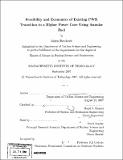| dc.contributor.advisor | Mujid S. Kazimi. | en_US |
| dc.contributor.author | Beccherle, Julien | en_US |
| dc.contributor.other | Massachusetts Institute of Technology. Dept. of Nuclear Science and Engineering. | en_US |
| dc.date.accessioned | 2009-03-16T19:41:33Z | |
| dc.date.available | 2009-03-16T19:41:33Z | |
| dc.date.copyright | 2007 | en_US |
| dc.date.issued | 2007 | en_US |
| dc.identifier.uri | http://hdl.handle.net/1721.1/44776 | |
| dc.description | Thesis (S.M.)--Massachusetts Institute of Technology, Dept. of Nuclear Science and Engineering, 2007. | en_US |
| dc.description | Includes bibliographical references (p. 135). | en_US |
| dc.description.abstract | The internally and externally cooled annular fuel is a new type of fuel for PWRs that enables an increase in core power density by 50% within the same or better safety margins as the traditional solid fuel. Each annular fuel assembly of the same side dimensions as the solid fuel has 160 annular fuel rods arranged in a 13x13 array. Even at the much higher power density, the fuel exhibits substantially lower temperatures and a MDNBR margin comparable to that of the traditional solid fuel at nominal (100%) power. The major motivation for such an up-rate is reduction of electricity generation cost. Indeed, the capital cost per kWh(e) of the construction is smaller than the standard construction of a new reactor with solid fuel. Elaborating on previous work, we study the economic payoff of such an up-rate of an existing PWR given the expected cost of equipment and also cost of money using different assumptions. Especially, the fate of the already bought solid fuel is investigated. It is demonstrated that the highest return on investment is obtained by gradually loading annular fuel in the reactor core such that right before shutting the reactor down for the up-rate construction, two batches in the core are of annular fuel. This option implies running a core with a mixture of both annular fuel and solid fuel assemblies. In order to prove the technical feasibility of such an option, the thermal-hydraulics of this mixed core is investigated and the Minimum Departure From Nucleate Boiling is found to be either unaffected or even improved by using a mixed core. Consequently, a neutronic model is developped to verify and validate the neutronic feasibility of the transition from solid fuel to annular fuel. | en_US |
| dc.description.abstract | (cont.) The overall conclusion of this work is that annular fuel is a very promising option for existing reactors to increase by 50% their power, because it enables such an uprate at very attractive return on investement. We show that, by a smart management of the transition, a return on investment of about 22 to 27 % can be achieved. | en_US |
| dc.description.statementofresponsibility | by Julien Beccherle. | en_US |
| dc.format.extent | 135 p. | en_US |
| dc.language.iso | eng | en_US |
| dc.publisher | Massachusetts Institute of Technology | en_US |
| dc.rights | M.I.T. theses are protected by
copyright. They may be viewed from this source for any purpose, but
reproduction or distribution in any format is prohibited without written
permission. See provided URL for inquiries about permission. | en_US |
| dc.rights.uri | http://dspace.mit.edu/handle/1721.1/7582 | en_US |
| dc.subject | Nuclear Science and Engineering. | en_US |
| dc.title | Feasibility and economics of existing PWR transition to a higher power core using annular fuel | en_US |
| dc.type | Thesis | en_US |
| dc.description.degree | S.M. | en_US |
| dc.contributor.department | Massachusetts Institute of Technology. Department of Nuclear Science and Engineering | |
| dc.identifier.oclc | 300289306 | en_US |
